Education – automatic promotions fudge data and corrode standards
Last week, the legal department of the government of India finally agreed to modify the Right to Education (RTE) Act (http://mhrd.gov.in/rte). The RTE was successfully steered through Parliament in 2009. Sadly, few realised at that time how disastrous some of the provisions of the Act would be both for education and for national pride (http://www.asiaconverge.com/2010/05/sibals-kiss-of-death/).
 Three clauses were considered worrisome:
Three clauses were considered worrisome:
- Chapter II , 4: Where a child above six years of age has not been admitted in any school or, though admitted, could not complete his or her elementary education, then he or she shall be admitted in a class appropriate to his or her age. Therefore, any child who was, say, 10 years old, but had not studied any of the subjects taught in earlier classes, must now be admitted to Class V.
- Chapter IV, 16: No child admitted in a school shall be held back in any class or expelled from school till the completion of elementary education [the government defined this as compulsory automatic promotion till Std VII). More on this below.
- Chapter IV, 17 says: No child shall be subjected to physical punishment or mental harassment. There is no definition of the phrase mental harassment. Is a teacher’s scolding tantamount to mental harassment?
The worst prescription was that automatic compulsory promotion would prevent any year-wise filtering of students. The accumulation of rot in Std VIII prevented school managements from detaining over 35% of the students in that year. State governments too ensured that the failing percentages were not too low SSC examinations. A good part of school output thus got reduced to sludge.
The present government finally decided to ban automatic compulsory promotions. But it decided to limit such promotions to Std VI instead of Std VIII.
But why? After all, all data on education is given for primary education (Std I-V), secondary education (Std VI-X) and higher secondary education (Std XI-XII). All courses after this level are clubbed under higher education. So why not stop automatic promotions after Std V?
A look at the numbers alongside suggests a possible explanation. Table 1 shows that even in spite of automatic promotions, dropout numbers continued to soar. Enrolments to Std VI had fallen from 57.5% of students enrolling for primary education in 2014 to 56.9% in 2015. If the government had stopped automatic promotions from Std V, dropout ratios to secondary education could have been higher. The government is keen on showing the world that it has improved secondary school enrolment (under the Millennium Development Goals). So why earn poor marks. A little fudge works splendidly.
Also remember that the largest sums are spent on school education. So an inflated number of students means more money sloshing around. And automatic promotion precludes accountability as well. So even though this government understood how automatic promotion was corroding educational standards, it chose to limit them only after Std VI. Clearly, what matters is impressive numbers.
But watch another oddity.
First, see how enrolment at each successive level has dropped. In 2015, enrolments from primary to secondary dropped from 100% (we assume this number to be 100% for purposes of convenience) to 56.96%. The number then falls to 38.12% at the Secondary stage. It falls further to 34% at the higher secondary level. That’s normal. The tapering of enrolment is to be expected.
But watch higher education. The number jumps to an unbelievable 107.96%. What’s happening?
Evidently, students who had not opted to pursue higher education and had dropped out have suddenly begun rushing to colleges. That could be because of several factors.
- Most people perceive employment chances to be better if the candidate has a graduation certificate. Few warn them about the dangers of a poorly educated graduate joining the swelling ranks of the educated unemployed.
- Many students opt for higher merely to preoccupy themselves because enough jobs are not available. Pursuit of higher education postpones the reality of unemployment from sinking in.
- Increasing awareness of the glamour surrounding college education.
Irrespective of the reason, the clamour for admission by millions of (sub-standard) students makes colleges a perfect ground for ferment and politics. That results in the further corrosion of higher education as well. Not surprisingly, the best of organizations – TCS, McKinseys, Nasscom – have gone on record stating that barely 30% of the graduates are employable.
Now that poses a big problem. As Table 2 shows, the total pool of graduates (arts, science, engineering, management, medicine etc) accounts for just 3.6% of India’s population. Of these at least half are unemployable. So you have the entire service industry growth propelled by just 1.8% of the population.
Higher education thus needs to be encouraged. But school education needs to be tightened first. More filtering is required. Without that, much of sludge of schools will knock at college doors. And five years of higher education will fail to cure the rot of 10 years of bad school education.





































COMMENTS